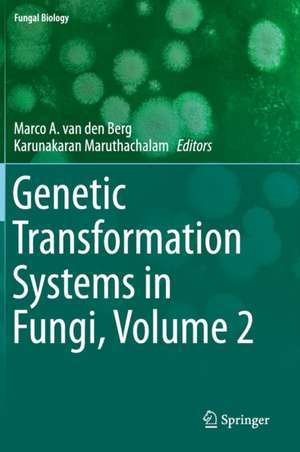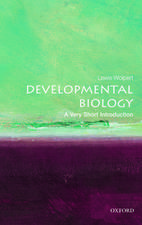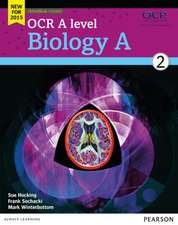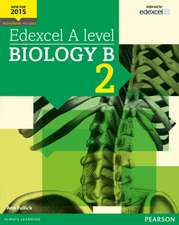Genetic Transformation Systems in Fungi, Volume 2: Fungal Biology
Editat de Marco A. van den Berg, Karunakaran Maruthachalamen Limba Engleză Hardback – 20 noi 2014
| Toate formatele și edițiile | Preț | Express |
|---|---|---|
| Paperback (1) | 947.50 lei 6-8 săpt. | |
| Springer International Publishing – 23 aug 2016 | 947.50 lei 6-8 săpt. | |
| Hardback (1) | 954.93 lei 6-8 săpt. | |
| Springer International Publishing – 20 noi 2014 | 954.93 lei 6-8 săpt. |
Din seria Fungal Biology
- 18%
 Preț: 1122.72 lei
Preț: 1122.72 lei - 15%
 Preț: 658.22 lei
Preț: 658.22 lei - 18%
 Preț: 1110.72 lei
Preț: 1110.72 lei - 20%
 Preț: 544.49 lei
Preț: 544.49 lei - 18%
 Preț: 948.61 lei
Preț: 948.61 lei - 18%
 Preț: 960.42 lei
Preț: 960.42 lei - 24%
 Preț: 1074.47 lei
Preț: 1074.47 lei - 18%
 Preț: 1228.96 lei
Preț: 1228.96 lei - 15%
 Preț: 635.01 lei
Preț: 635.01 lei - 18%
 Preț: 1403.98 lei
Preț: 1403.98 lei - 18%
 Preț: 1117.99 lei
Preț: 1117.99 lei - 15%
 Preț: 657.57 lei
Preț: 657.57 lei - 18%
 Preț: 958.88 lei
Preț: 958.88 lei - 18%
 Preț: 951.77 lei
Preț: 951.77 lei - 18%
 Preț: 957.75 lei
Preț: 957.75 lei - 18%
 Preț: 1112.15 lei
Preț: 1112.15 lei - 18%
 Preț: 998.34 lei
Preț: 998.34 lei - 18%
 Preț: 1117.99 lei
Preț: 1117.99 lei - 18%
 Preț: 1120.18 lei
Preț: 1120.18 lei - 15%
 Preț: 643.34 lei
Preț: 643.34 lei - 15%
 Preț: 640.71 lei
Preț: 640.71 lei - 18%
 Preț: 951.14 lei
Preț: 951.14 lei - 18%
 Preț: 948.92 lei
Preț: 948.92 lei - 15%
 Preț: 644.95 lei
Preț: 644.95 lei - 18%
 Preț: 1844.67 lei
Preț: 1844.67 lei - 18%
 Preț: 947.67 lei
Preț: 947.67 lei - 18%
 Preț: 1111.67 lei
Preț: 1111.67 lei - 18%
 Preț: 1010.65 lei
Preț: 1010.65 lei - 18%
 Preț: 953.35 lei
Preț: 953.35 lei - 18%
 Preț: 959.19 lei
Preț: 959.19 lei - 15%
 Preț: 645.28 lei
Preț: 645.28 lei
Preț: 954.93 lei
Preț vechi: 1164.56 lei
-18% Nou
Puncte Express: 1432
Preț estimativ în valută:
182.74€ • 189.63$ • 152.74£
182.74€ • 189.63$ • 152.74£
Carte tipărită la comandă
Livrare economică 15-29 martie
Preluare comenzi: 021 569.72.76
Specificații
ISBN-13: 9783319105024
ISBN-10: 3319105027
Pagini: 288
Ilustrații: XIV, 270 p. 38 illus., 26 illus. in color.
Dimensiuni: 178 x 254 x 21 mm
Greutate: 0.72 kg
Ediția:2015
Editura: Springer International Publishing
Colecția Springer
Seria Fungal Biology
Locul publicării:Cham, Switzerland
ISBN-10: 3319105027
Pagini: 288
Ilustrații: XIV, 270 p. 38 illus., 26 illus. in color.
Dimensiuni: 178 x 254 x 21 mm
Greutate: 0.72 kg
Ediția:2015
Editura: Springer International Publishing
Colecția Springer
Seria Fungal Biology
Locul publicării:Cham, Switzerland
Public țintă
ResearchCuprins
Anastomosis and Heterokaryon Formation.- Induction of the Sexual Cycle in Filamentous Ascomycetes.- What Have We Learned by Doing Transformations in Neurospora tetrasperma?.- Repeat-induced Point Mutation: A Fungal-specific, Endogenous Mutagenesis Process.- Calculating RIP Mutation in Fungal Genomes Using RIPCAL.- Fungal Transposable Elements.- In vivo Targeted Mutagenesis in Yeast using TaGTEAM.- RNA Silencing in Filamentous Fungi: from Basic to Applications.- RNAi-mediated Gene Silencing in the Beta-lactam Producers Fungi Penicillium chrysogenum and Acremonium chrysogenum.- Controlling Fungal Gene Expression Using the Doxycycline-Dependent Tet-ON System in Aspergillus fumigates.- Expanding the Repertoire of Selectable Markers for Aspergillus Transformation.- Arginase (agaA) as a Fungal Transformation Marker.- Transformation of Ascomycetous Fungi using Autonomously Replicating Vectors.- A Recyclable and Bidirectionally Selectable Marker System for Transformation of Trichoderma.- Split Marker-Mediated Transformation and Targeted Gene Disruption in Filamentous Fungi.- Integrated Automation for Continuous High-Throughput Synthetic Chromosome Assembly and Transformation to Identify Improved Yeast Strains for Industrial Production of Biofuels and Bio-based Chemicals.- Imaging Flow Cytometry and High-throughput Microscopy for Automated Macroscopic Morphological Analysis of Filamentous Fungi.- Yeast Cell Electroporation in Droplet-Based Microfluidic Chip.- Identification of T-DNA Integration Sites: TAIL-PCR and Sequence Analysis.- Genetic and Genomic Manipulation in Aspergillus niger.- Genetic Manipulation of Meyerozyma guilliermondii.
Notă biografică
Marco A. van den Berg, PhD
Principal Scientist Applied Biochemistry and Screening
DSM Biotechnology Center
Delft, The Netherlands
Karunakaran Maruthachalam, PhD
Current: Research Scientist
Global Marker Technology Lab, DuPont-Pioneer
DuPont Knowledge Center
Andhra Pradesh, India
Previous: Molecular Biologist
California Seed and Plant Labs
Pleasant Grove, CA, USA
Principal Scientist Applied Biochemistry and Screening
DSM Biotechnology Center
Delft, The Netherlands
Karunakaran Maruthachalam, PhD
Current: Research Scientist
Global Marker Technology Lab, DuPont-Pioneer
DuPont Knowledge Center
Andhra Pradesh, India
Previous: Molecular Biologist
California Seed and Plant Labs
Pleasant Grove, CA, USA
Textul de pe ultima copertă
Several different transformation techniques have been developed over the years and readily shown to be decisive methods in fungal biotechnology. While Volume 1 provided its readers with an in-depth understanding of how the transformation of DNA is used to understand the genetic basis behind these fungal traits, Volume 2 of this text describes the transformation associated methods, tools, and many relevant elements available to the modern fungal researcher.
With ample illustrative examples and protocols, Genetic Transformation Systems in Fungi, Volume 2 is meant not only as a reference guide for the experienced researcher, but also as an a learning tool for the emerging scientist.
With ample illustrative examples and protocols, Genetic Transformation Systems in Fungi, Volume 2 is meant not only as a reference guide for the experienced researcher, but also as an a learning tool for the emerging scientist.
Caracteristici
The most comprehensive book on fungal transformation methods The best protocols to be applied in your lab Includes the latest tools and techniques Includes supplementary material: sn.pub/extras










